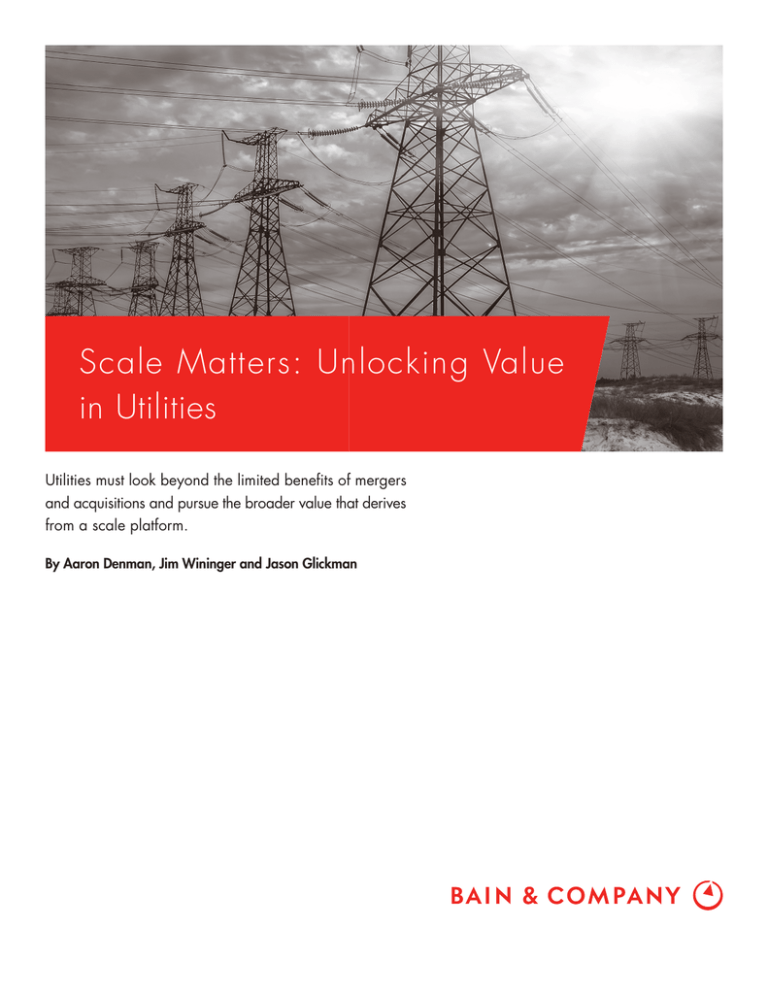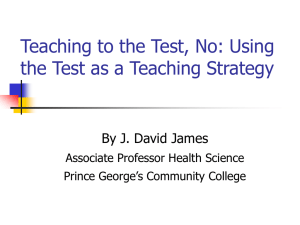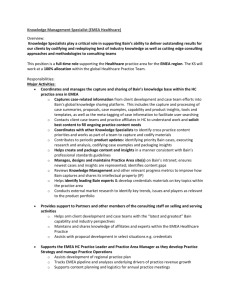
Scale Matters: Unlocking Value
in Utilities
Utilities must look beyond the limited benefits of mergers
and acquisitions and pursue the broader value that derives
from a scale platform.
By Aaron Denman, Jim Wininger and Jason Glickman
Aaron Denman is a principal with Bain & Company in Chicago. Jim Wininger is
a partner in Bain’s Atlanta office, and Jason Glickman is a Bain partner in San
Francisco. All three work with Bain’s Global Utilities practice.
Copyright © 2016 Bain & Company, Inc. All rights reserved.
Scale Matters: Unlocking Value in Utilities
by requiring the newly merged company to maintain
multiple administrative centers (one in each region) or
requiring any savings to be reflected in rate reductions.
Such constraints are in addition to the difficulties of
gaining merger approval from the regulators of acquisition targets. So the value of inorganic growth pales
compared to other industries.
Utilities have been reliable performers for investors looking for long-term, stable growth, and this steady flow of
investment funds has allowed utilities to build and upgrade their power generation and their transmission and
distribution infrastructure. However, utilities face an unprecedented challenge as electricity consumption flattens
out due to a combination of factors, including rising energy efficiency, distributed generation and a post-recession
shift to less energy-intensive industries (see Figure 1).
Without the benefit of demand growth, executives looking
at this flat curve must now find other ways to deliver on
the earnings growth targets that shareholders expect.
Their thoughts, naturally, turn to scale.
In utilities, the real benefit of scale doesn’t come from
short-term, deal-driven, back-office synergies. Rather, it
comes from developing a scale platform and tapping a
broad range of benefits, including not only traditional
cost benefits but also a wider application of repeatable processes and more effective use of capital (see Figure 2).
Mergers and acquisitions are one of the most visible
ways to gain benefits from scale, whether from merging across borders, acquiring gas local distribution
companies (LDCs) or increasing the size of a power
generation portfolio. Utilities, however, are uniquely
challenged in this aspect because of regulatory constraints that eat up potential efficiency gains; for example,
Benefits of a scale platform
Scale creates different kinds of value, and companies
should adopt different business models and practices
to capitalize on the kinds of scale advantages that they
are pursuing.
Figure 1: Electricity consumption has flattened since 2007
Total retail electricity sales (US, MWh)
4.0B
0% CAGR
3.5
2% CAGR
3.0
2.5
0
1990
1995
2000
2005
Note: MWh is megawatt hours
Sources: US Energy Information Administration’s Annual Energy Outlook 2015; Bain & Company analysis
1
2010
2014
Scale Matters: Unlocking Value in Utilities
Figure 2: Utilities derive value from scale through cost efficiencies, deployment of repeatable processes
and enhancement of financial breadth
Cost synergies
• Tap mergers and acquisitions (M&A) synergies to reduce costs in field operations, fuel purchasing and
administrative and general.
Repeatability
• Develop standard processes and technologies to improve field force and plant operations, modernize
the distribution grid and create operational excellence.
• Enable cost efficiency above and beyond traditional sources of value from scale.
• Increase clout to influence policy at local (rate making) and national (environmental policy) levels.
Capital deployment
• Expand the breadth and depth of investment opportunities, including experimentation and risk taking
in adjacent businesses.
• Improve investment economics by taking advantage of investment tax credit (ITC) and production tax
credit (PTC).
Source: Bain & Company
Traditional cost benefits. The regulatory constraints
on utilities can make it difficult to realize some of
the traditional cost benefits of scale. Acquisitions in
neighboring regions offer some opportunities, but
utilities may struggle to merge field operations
when territories are not adjacent. Frequently, utilities cannot merge field operations because the territories are not near each other. Merging utilities
can expect to take a good chunk out of administrative costs, but since such costs also make up a relatively small proportion of company expenses, the
overall impact might be minimal. Often, merged
utilities cannot even reap the savings of combining
back-office operations because regulatory bodies
typically want a commitment that the merged utility
will keep a presence in each territory before they
agree to a deal. Though difficult to quantify, a more
significant gain from M&A is a greater influence in
shaping regulatory policy, which helps unlock value
from rate constructs and national policies.
Even more opportunity, however, comes from two other
aspects of scale.
Repeatability. Repeatability helps scale players reduce
complexity and costs, and thus can help keep the growth
of customers’ bills lower than inflation. Companies
that have developed a competitive advantage through
their repeatable models can then extend these models
when they acquire other companies, vastly increasing
the scale benefits. Opportunities for repeatable models
include investment decisions and deployment practices
for new technologies (such as advanced metering infrastructure or distributed management systems) and
standardization of the processes that field forces use.
Repeatability across a sustained cost-transformation
program or deployment of digital capabilities can also
create significant value. For example, wholesale energy
supplier NextEra has built one of the largest renewable
portfolios in the US with repeatable practices for identifying attractive niches (such as those with existing
transmission capacity) and scale benefits in buying
2
Scale Matters: Unlocking Value in Utilities
Executives also need to be sure that their scale ambitions
can withstand a range of potential scenarios. In the early
2000s, the EU’s utility sector experienced consolidation
along the same lines as we see in North America today.
This trend resulted in several very large, cross-border
utilities that were successfully outperforming their
mid-tier rivals—until the EU’s regulatory landscape
shifted dramatically to encourage and reward investment
in renewable sources such as wind and solar. Scale did
not protect these large EU utilities from the influx of
capital into smaller, agile, distributed energy start-ups.
equipment like turbine blades. These models help
NextEra identify good deals and attractive power purchase agreements.
Capital deployment. Scale allows larger companies to
assume greater risks—risks that would be “bet the company” moves for smaller firms, which would need to devote a greater percentage of their operating cash flow
to the integration. For example, Duke Energy, Southern
Company and Dominion have all made adjacent moves
into gas distribution that carry an acceptable level of risk
for each of these very large, vertically integrated utilities
but would be much more difficult for smaller competitors to take on. Similarly, other utilities have built out
adjacencies that extend the scale and strength of the core
business, including Sempra in liquid natural gas (LNG),
NextEra in large-scale renewables and Dominion in
midstream gas infrastructure.
Only after the core business is on track to deliver peak
value should the focus be on how to build scale, including M&A planning, to create more value for customers,
shareholders and employees.
Implications for the utility industry
Scale also enables better use of tax incentives. For
example, the extension of both the production tax
credit (PTC) and investment tax credit (ITC) in late
2015 has created significant value for companies
that can develop large-scale solar and wind generation. However, companies with smaller tax burdens
might not be able to take full advantage of these incentives. Large companies with a significant tax burden are better able to capture that value. For example,
Berkshire Hathaway Energy has built a significant,
unregulated large-scale renewable portfolio based
on its ability to benefit from related tax incentives.
This broader, comprehensive look at the value of scale
has important implications for each of the key players
in the utility sector.
Vertically integrated electric utilities. Consolidation in
the sector has reduced the number of vertically integrated
utilities in North America. Further consolidation could
create more scale benefits, particularly in terms of repeatability, which creates standardization and cost efficiencies across the value chain while expanding investment
opportunities in gas infrastructure and large-scale
renewables. Executives at vertically integrated utilities
can prepare by ensuring that they are developing repeatable processes within their organizations, laying
the groundwork to extend those processes to any future acquisitions.
Developing a scale platform and successfully executing
at scale is a labor- and capital-intensive process that
has a greater chance for success when a company is
already operating near full potential in its core business. Before pursuing greater scale, executives should
first tend to any easier and less expensive ways to unlock
value in the organization. Is the company taking advantage of all available efficiencies in its current organization? Is the core business operating at full potential?
Could the company take advantage of investment opportunities within its current grid or power plant portfolio,
without the need for acquisitions?
Mid-tier electric utilities. Lack of scale might limit midtier electric utilities’ ability to unlock the full set of
benefits, restricting their growth opportunities. Over
the long term, mid-tier players might find it challenging
to compete effectively without gaining scale, as happened
in the EU during its consolidation wave a decade ago.
At that time, a large gulf opened between the biggest
players, who outperformed mid-tier players significantly
until shifts in the regulatory and tax structure reshuffled
the landscape in favor of renewables and more nimble
3
Scale Matters: Unlocking Value in Utilities
players. Executives in these mid-tier companies should
determine whether they will act as a consolidator, a
bystander or a target for consolidation. Consolidators
should continue to build value from their core operations
while exploring M&A with nearby utilities of similar
size and creating partnerships and joint ventures with
larger utilities.
Gas LDCs. Unlike electric utilities, the gas distribution
industry has not consolidated and remains mostly fragmented. However, given lower gas prices, increasing
infrastructure needs and greater demands for pipeline integrity, this trend is unlikely to persist. Electric utilities
might continue to acquire gas LDCs, as in the deals
referenced earlier. In addition, more regional or national
gas LDCs might emerge as they build scale to unlock
value from repeatability and to meet the coming wave
of regulatory standards.
Electric distribution companies (EDCs). From New York
to Texas to California, the demands to modernize the
grid and incorporate more distributed energy resources
are intensifying. However, without standardization
across distribution networks, costs and complexity are
also likely to increase. EDCs should explore a twopronged approach. First, a roll-up of EDCs along common geographic corridors (as seen with Utility Service
New England) could create significant scale advantages
that unlock value for customers and shareholders. Second,
EDCs should work closely with regulators and ESCOs to
explore alternative customer models that might be more
effective for companies and their customers.
For executives across the utility ecosystem, building a
scale platform will become increasingly important as
they try to deliver against shareholder expectations, even
as the underlying economics of the industry shift. The
sector is likely to experience further consolidation—
and executives will need to make sure that their skills
in deal making and post-merger integration are up to
the task. Equally important will be their ability to create
benefits from their scale platform, far beyond the simple
cost efficiencies that drive M&A in most other industries. They will need clarity about how they intend to
generate value from scale, and they will then need
to build the internal capabilities necessary to support
the scale platform.
Energy service companies (ESCOs). Although larger
ESCOs (including Direct Energy and Constellation) have
formed over the past decade, the market remains highly
fragmented, with smaller ESCOs and many retail customers—representing more than 40% of sales measured
in MWh—still residing with incumbent EDCs. Larger
ESCOs can operate more efficiently so it’s in their best
interests to continue to consolidate, which can also
reduce costs for their customers.
4
Shared Ambit ion, True Results
Bain & Company is the management consulting firm that the world’s business leaders come
to when they want results.
Bain advises clients on strategy, operations, technology, organization, private equity and mergers and acquisitions.
We develop practical, customized insights that clients act on and transfer skills that make change stick. Founded
in 1973, Bain has 53 offices in 34 countries, and our deep expertise and client roster cross every industry and
economic sector. Our clients have outperformed the stock market 4 to 1.
What sets us apart
We believe a consulting firm should be more than an adviser. So we put ourselves in our clients’ shoes, selling
outcomes, not projects. We align our incentives with our clients’ by linking our fees to their results and collaborate
to unlock the full potential of their business. Our Results Delivery® process builds our clients’ capabilities, and
our True North values mean we do the right thing for our clients, people and communities—always.
Key contacts in Bain’s Global Utilities practice
Americas
Matt Abbott in Los Angeles (matt.abbott@bain.com)
Neil Cherry in San Francisco (neil.cherry@bain.com)
António Farinha in São Paulo (antonio.farinha@bain.com)
Jason Glickman in San Francisco (jason.glickman@bain.com)
Mark Gottfredson in Dallas (mark.gottfredson@bain.com)
Joseph Herger in San Francisco (joseph.herger@bain.com)
Pratap Mukharji in Atlanta (pratap.mukharji@bain.com)
Tina Radabaugh in Los Angeles (tina.radabaugh@bain.com)
Alex Ramanathan in Chicago (alexandra.ramanathan@bain.com)
Rodrigo Rubio in Mexico City (rodrigo.rubio@bain.com)
Joseph Scalise in San Francisco (joseph.scalise@bain.com)
Bruce Stephenson in Chicago (bruce.stephenson@bain.com)
Jim Wininger in Atlanta (jim.wininger@bain.com)
Stephan Zech in Los Angeles (stephan.zech@bain.com)
Asia-Pacific
Sharad Apte in Bangkok (sharad.apte@bain.com)
Wade Cruse in Singapore (wade.cruse@bain.com)
Miguel Simoes de Melo in Sydney (miguel.simoes-demelo@bain.com)
Amit Sinha in New Delhi (amit.sinha@bain.com)
Europe,
Middle East
and Africa
Alessandro Cadei in Milan (alessandro.cadei@bain.com)
Julian Critchlow in London (julian.critchlow@bain.com)
Kim Petrick in Dubai (kim.petrick@bain.com)
Juan Carlos Gay in London (juancarlos.gay@bain.com)
Olga Muscat in London (olga.muscat@bain.com)
Kim Petrick in Dubai (kim.petrick@bain.com)
Timo Pohjakallio in Helsinki (timo.pohjakallio@bain.com)
For more information, visit www.bain.com








